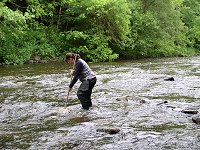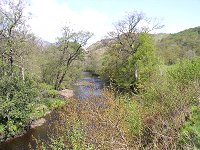

Sampling site images
with links to samples
1: Isle of Islay
|
|
Loch Tallant is a shallow loch in a
nutrient-poor peaty basin: marginal vegetation is gradually encroaching
on the open water and the loch is now only a remnant of the original. |
More images of
Islay and its lochs here:
Sampling results:
2000
2002
2003 2004
2005 2006 2018-19
2: Hidden Lochan, near Aviemore.
|
|
Hidden Lochan is in a densely (planted) forested area near Aviemore. The lochan is formed in a peaty depression and the waters are highly coloured. That's me using a plankton net. |
3: Green Lochan, near Aviemore.
|
|
|
4: Lochan an Eilein, near Aviemore.
|
|
|
5: Wester Ross, near Achiltibuie.
|
|
|
|
|
|
7: Millport Reservoir
|
|
|
|
|
Loch
Skeen lies in a glacial hanging valley in the Scottish Borders area:
the Tail Burn which drains it cascades into the Moffat Water, forming
a waterfall called the Grey Mare's Tail. The area is popular with tourists,
and a steep but well-constructed path leads up the side of the waterfall
to the loch. |
 |
The Trossachs area includes the Loch Ard catchment (Loch Ard pictured left) which has been the focus of much monitoring and research into freshwater acidification, as has Loch Chon. |
10: Bemersyde Moss, The Scottish Borders
 |
Bemersyde moss is a shallow loch and surrounding wetland near Melrose, and an important local bird reserve. Napier biologists have been engaged in a long-term study of nutrient levels and their relationship with the bird community and other aquatic life. |
11: Ettrick and Yarrow Waters, the Borders.
 |
The Ettrick and the Yarrow are rivers which form major tributaries of the river Tweed, a famous salmon fishing river in the Scottish and English border country. The algal samples were taken during a project to investigate possible reasons for differences in salmon recruitment in the two rivers. |
12: River Creran, west highlands
 |
The River Creran lies on the west coast of Scotland, running into the fjordic Loch Creran. It drains a mountainous catchment with a small human population. Some agriculture is practiced on the drained strath (flood plain). |
 |
The River Almond has a highly populated catchment lying mainly in West Lothian to the west of Edinburgh. It has been industrialised since the beginning of the industrial revolution, being the birthplace of the shale oil industry ("Paraffin Young"), and saw iron ore smelting and deep - mined coal at a multitude of locations - all now ceased. It provides a complete contrast in terms of topography and land use to the Creran catchment. |
14: Nepal
| Samples were collected in Nepalese rivers in the foothills of the Himalaya by Ian Martin, alongside invertebrate and water samples taken for his Honours project, while conducting a fishing/rafting trip in Nepal. |
John Kinross